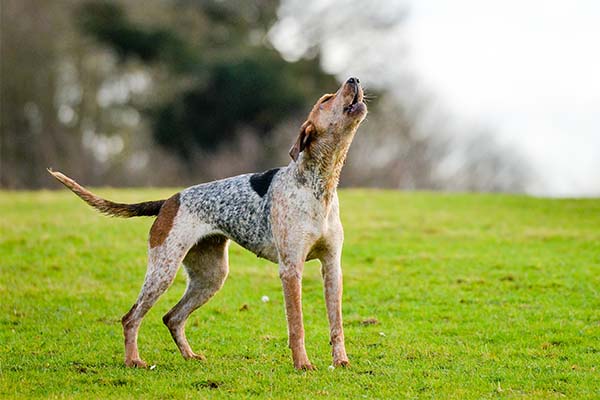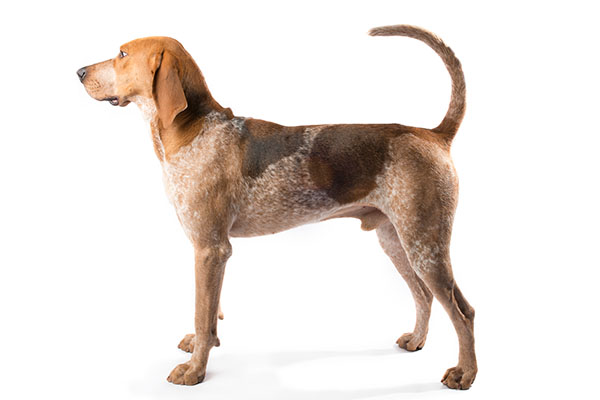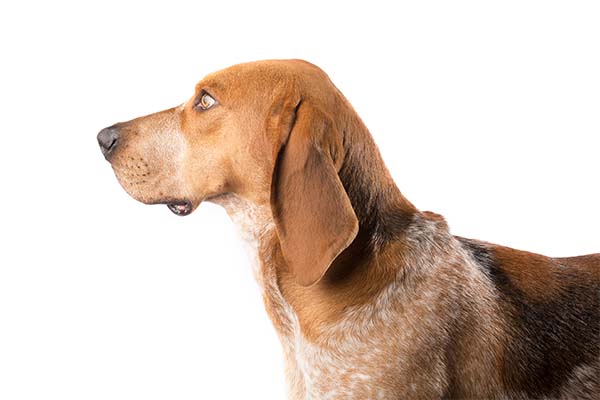These sleek and racy, lean but muscular hounds work dusk to dawn in pursuit of the wily raccoon. The sight of the American English Coonhound tearing through the moonlit woods, all sinew and determination, bawling their lusty night music, is coon-hunter heaven. Standing as high as 26 inches at the shoulder, American English Coonhounds are deep-chested, sweet-faced athletes beloved by sportsmen for their speed and endurance. Stretched tightly across the athletic frame is a medium-length coat of various patterns, some with ticking. The head is broad with a domed skull, with soft, low-hung ears and dark-brown eyes that glow with warmth and kindness. American English Coonhounds are mellow when off duty but tenacious and stubborn in pursuit of their ring-tailed prey. Their work drive and energy, the patience it takes to train them for things other than coon hunting, and their loud, ringing bark can make the breed a bad fit as house pets for novice owners. Some passionate fans of American English Coonhounds feel that without a sporting outlet for this breed’s houndy virtues, you’re simply wasting a good dog.
American English Coonhound
Average sizes and life
expectancy of the breed.
Height
24-26 inches (male)
23-25 inches (female)
Weight
45-65 pounds
Life Expectancy
11-12 years
Breed Traits & Characteristics
About the Breed

Owning a dog is not just a privilege; it’s a responsibility. They depend on us for, at minimum, food and shelter, and deserve much more. When you take a dog into your life, you need to understand the commitment that dog ownership entails.
 Health
Health
Still bred primarily as a hard-working dog, which must have an efficient physical condition, the American English Coonhound is generally a healthy breed. Responsible breeders will screen their stock for health conditions such as hip and elbow dysplasia as well as eye disorders such as progressive retinal atrophy and cataracts. His ears should be checked regularly to remove excess wax and debris. Like other large and deep-chested breeds, he can experience bloat, a sudden, life-threatening stomach condition. Owners should learn the signs of bloat and what to do should it occur.
Recommended Health Tests From the National Breed Club:
- No recommended health tests
 Grooming
Grooming
 Exercise
Exercise
 Training
Training
 Nutrition
Nutrition
History
The American English Coonhound is American by birth, English by ancestry. They’re one of six AKC coonhound breeds that frontiersmen devised to specialize on trailing and treeing North America’s perfect source of food, fat, and fur: the raccoon. It’s said that the American English Coonhound are descended from English Foxhounds brought to America in the early 1800s. Foxhunting had been a popular pastime in Great Britain’s southern colonies in America since the late 1600s. George Washington maintained an avid interest in English-style horse-and-hound foxhunts even as he commanded the army that would deprive England of its American colonies. Importations of English Foxhounds during America’s formative years refreshed the gene pool used by Colonial breeders to create America’s coonhound breeds.
Backwoods breeders crossed foxhounds with other breeds to create the American English, once known as the English Fox and Coonhound, as it could hunt foxes by day and raccoons by night. As the breed came to specialize on nocturnal raccoon hunts, it acquired its current name. (The breed was also known for a time as the Redtick Coonhound and, simply, the English Coonhound.) Since Colonial times, the American English has been immensely popular among the tight fraternity of coon hunters. “If I couldn’t have an English hound,” a veteran raccooner tells says, “I’d give up hunting.” Today’s American English is considered by some experts as the fastest of the coonhound breeds.





